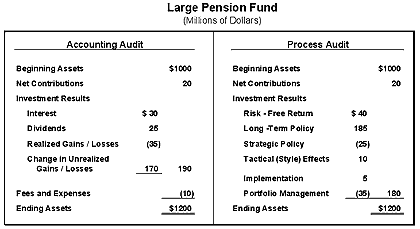Distinguishing Features
Several features distinguish the Audit from conventional investment
evaluation approaches.
One such feature is the presentation of results in terms of decision
outcomes rather than investment return components. The table below
accounts for the changes in a fund's value for two different purposes.
The process approach, utilized by the Asset Allocation Audit, is
far more useful for control and oversight purposes.

Another feature is the Audit's presentation of results in the form management
is accustomed to using in its cost control function: dollars of
increase or decrease from established forecasts and benchmarks.
This approach quantifies answers to such questions as:
- How much extra return have we gained over risk-free, unmanaged
alternatives?
- How much value has our most recent policy change added or lost?
- How much value has each portfolio added above an index fund
. . . net of fees?
- How much came from market timing and how much from security
selection?
- How much value has advice from our consultant added or lost?
If you are like most decision-makers on the sponsor's side of the
table, you don't have the answers to such questions simply because
the information has not been generated. Typical reports from managers
and custodians don't contain it. Total rates of return won't tell
you either.
The Asset Allocation Audit solves this problem by disaggregating
the total return along the boundaries of delegated authority and
responsibility, greatly strengthening the fiduciaries' control function.
It delineates the impact of all decisions from the sponsor's setting
of asset class policy to an outside manager's tactical market timing
and security selection. Because any decision segment can be replaced
with a passive alternative, unproductive components can be eliminated
without disturbing the policy or any of the other elements of the
investment program.
This makes the Audit especially useful in dealing with outside
portfolio managers. By presenting their results in reference to
established standards, the Audit enables pension fund fiduciaries
to view these portfolio managers much the same as company employees,
who are hired to do certain jobs management believes need to be
done.
One key feature clearly distinguishes the Audit from conventional
performance reporting. That feature is its presentation of results
as they develop. Period-based performance numbers are often distorted
by the start and end dates for the period being evaluated. A one-month
or one-year shift can lead to an entirely different conclusion about
the period performance. The Audit reveals the evolution of the period
performance, not just the overall result. Its methodology creates
trails of monthly data that show how and when the results developed
over time. This mitigates period-based distortions, which limit
the management value of most other approaches to the presentation
of investment performance.
The Audit's "what if" capabilities add a research dimension.
Just using that function to analyze prospective managers and the
implications of possible future securities markets scenarios can
save staff people hundreds of hours each year. It can help answer
such questions as: How much value change should we expect from a
recurrence of the 1990's . . . or the 1970's?
There are other ways in which the Audit can be expected to earn
back its cost many times over. The changes that can be expected
to follow the Audit's installation include a clarification of roles
and expectations, fewer but more productive active managers, and
improved overall results at lower cost. The realities displayed
usually argue strongly for a shift of research resources from portfolio
managers to the corporate staff and management, who typically make
the high-impact decisions.
Until now this system has been accessible only through firms outside
the fund sponsor's organization. Now it is installed on an Internet
site, making it available to inside analysts who do not need to
be securities markets professionals. This enables them to continuously
and confidentially support directors and trustees without relying
upon outside service providers. Another alternative is to have the
Audit installed in-house and operate it independently.
It is worth noting that the input data required by this attribution
system are readily available from existing files. A clerical assistant
can quickly be trained to build and append these records.
The Audit is especially useful for educational purposes. In that
application it can be used to bring a valuable, more realistic,
easily understood perspective to fiduciaries who are not investment
professionals. It can give them the standards they need to confidently
organize their delegations of responsibility and hold their decision-makers
accountable for adding value by their efforts.
To Top
|